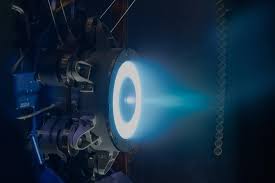ISRO’s First Electric Propulsion-Led Spacecraft (TDS-1)

- 28 Oct 2024
In News:
India's first home-grown electric propulsion satellite to be launched in Dec.
Key Highlights:
- Objective of TDS-1:
- Purpose: To demonstrate electric propulsion technology for satellite steering, using solar-powered ionized gas.
- Goal: Reduce reliance on chemical fuel, making satellites lighter and more efficient.
- Key Benefits of Electric Propulsion:
- Weight Reduction: The technology can significantly cut down satellite mass. For example, a satellite weighing 4 tonnes could be reduced to around 2 tonnes.
- Fuel Efficiency: By using electric propulsion, the need for chemical fuel is minimized, allowing for a more efficient journey to geostationary orbit.
- Technology Details:
- Fuel Used: Gases like Argon are ionized using solar power to create propulsion.
- Process: The ionized gas is expelled at high speeds to generate thrust, pushing the satellite towards its desired orbit.
- Historical Context:
- The technology was first used in GSAT-9 (South Asia Satellite) in 2017 but with imported Russian components.
- TDS-1 marks the first fully indigenous development of electric propulsion technology by ISRO, highlighting India’s increasing space autonomy.
- Significance for India’s Space Program:
- Self-Reliance: TDS-1 reflects ISRO’s growing capacity to develop advanced space technologies domestically.
- Future Prospects: This breakthrough is expected to lead to more efficient satellite designs, enhancing India’s competitiveness in the global space industry.
